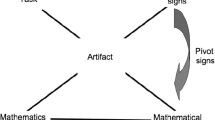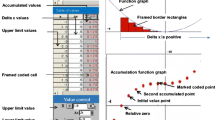Abstract
The present study was designed to identify the objectification processes involved in making sense of the concept of an indefinite integral when studied graphically in a dynamic technological environment. The study focuses on 11 pairs of 17-year-old students familiar with the concept of differentiation but not of integration. The students were asked to explain the possible connection between two linked dynamic graphs: the function and the primitive function graphs. The present study was guided by objectification theory, which considers artifacts to be fundamental to cognition and which views learning as the process of becoming aware of the knowledge that exists within a cultural context. In the course of two rounds of data analysis we identified six elements in the processes of objectification: objectifying the relationships between segments based on the location, inclination, and concavity of the function graph; and on the relationships between the zero, the extreme, and the inflection points in the function graph and the corresponding points in the primitive function graph.















Similar content being viewed by others
Notes
They had encountered the integral symbol and its computational uses in their physics and electronics lessons, however.
References
Arzarello, F., Paola, D., Robutti, O., & Sabena, C. (2009). Gestures as semiotic resources in the mathematics classroom. Educational Studies in Mathematics, 70(2), 97–109. doi:10.1007/s10649-008-9163-z.
Bartolini Bussi, M. G., & Mariotti, M. A. (2008). Semiotic mediation in the mathematics classroom: artifacts and signs after a Vygotskian perspective. In L. English (Ed.), Handbook of international research in mathematics education (2nd ed., pp. 746–783). New York: Routledge.
Berger, M. (2004). The functional use of a mathematical sign. Educational Studies in Mathematics, 55(1), 81–102.
Berry, J. S., & Nyman, M. A. (2003). Promoting students’ graphical understanding of the calculus. Journal of Mathematical Behavior, 22(4), 479–495.
Botzer, G., & Yerushalmy, M. (2008). Embodied semiotic activities and their role in the construction of mathematical meaning of motion graphs. International Journal for Computers in Mathematical Learning, 13(2), 111–134. doi:10.1007/s10758-008-9133-7.
Hughes-Hallett, D., & Gleason, A. (1994). Calculus. New York: Wiley.
Kaput, J., & Schorr, R. (2008). Changing representational infrastructures changes most everything: the case of SimCalc, algebra, and calculus. In G. Blume & K. Heid (Eds.), Research on technology and the teaching and learning of mathematics (Vol. 2, pp. 211–253)., Cases and perspective Charlotte: IAP-Information Age Publishing.
Mariotti, M. (2009). Artifacts and signs after a Vygotskian perspective: the role of the teacher. ZDM—The International Journal on Mathematics Education, 41(4), 427–440. doi:10.1007/s11858-009-0199-z.
Metaxas, N. (2007). Difficulties on understanding the indefinite integral. In J. H. Woo, H. C. Lew, K. S. Park, & D. Y. Seo (Eds.), Proceedings of the 31st Conference of the International Group for the Psychology of Mathematics Education, Vol. 3 (pp. 265–272). Seoul.
Noble, T., Nemirovsky, R., Wright, T., & Tierney, C. (2001). Experiencing change: the mathematics of change in multiple environments. Journal for Research in Mathematics Education, 32(1), 85–108.
Núñez, R. (2006). Do real numbers really move? Language, thought, and gesture: the embodied cognitive foundations of mathematics. In R. Hersh (Ed.), 18 unconventional essays on the nature of mathematics (pp. 160–181). New York: Springer.
Radford, L. (2003). Gestures, speech, and the sprouting of signs: a semiotic-cultural approach to students’ types of generalization. Mathematical Thinking and Learning, 5(1), 37–70.
Radford, L. (2008). The ethics of being and knowing: towards a cultural theory of learning. In L. Radford, G. Schubring, & F. Seeger (Eds.), Semiotics in mathematics education: epistemology, history, classroom, and culture (pp. 215–234). Rotterdam: Sense Publishers.
Radford, L., Bardini, C., Sabena, C., Diallo, P., & Simbagoye, A. (2005). On embodiment, artifacts, and signs: a semiotic-cultural perspective on mathematical thinking. In H. L. Chick & J. L. Vincent (Eds.), Proceedings of the 29th Conference of the International Group for the Psychology of Mathematics Education (Vol. 4, pp. 113–120). Australia: University of Melbourne.
Schwartz, J., & Yerushalmy, M. (1995). On the need for a bridging language for mathematical modeling. For the Learning of Mathematics, 15(2), 29–35.
Shternberg, B., & Yerushalmy, M. (2004). Didactic model–bridging a concept with phenomena. In Ihe Proceedings of the 28th Conference of the International Group for the Psychology of Mathematics Education, Vol. 4 (pp. 185–192). Norway: Bergan.
Shternberg, B., Yerushalmy, M., & Zilber, A. (2004). The Calculus Integral Sketcher. http://calculus.cet.ac.il/Lib/item.aspx?sID=DDE91E48-EB26-41B6-ABE3BACBADBCEA78&bPopup=1&bFitSize=1.
Thomas, M. O., Yoon, C., & Dreyfus, T. (2009). Multimodal use of semiotic resources in the construction of antiderivative. In R. Hunter, B. Bicknell, & T. Burgess (Eds.), Crossing divides. Proceedings of the 32nd Annual Conference of the Mathematics Education Research Group of Australasia, Vol. 2. Palmerston North: MERGA.
Thompson, P. W., Byerley, C., & Hatfield, N. (2013). A conceptual approach to calculus made possible by technology. Computers in the Schools, 30(1–2), 124–147. doi:10.1080/07380569.2013.768941.
Ubuz, B. (2007). Interpreting a graph and constructing its derivative graph: stability and change in students’ conceptions. International Journal of Mathematical Education in Science and Technology, 38(5), 609–637.
Yerushalmy, M. (1997). Mathematizing verbal descriptions of situations: a language to support modeling. Cognition and Instruction, 15(2), 207–264.
Yerushalmy, M., & Swidan, O. (2012). Signifying the accumulation graph in a dynamic and multirepresentation environment. Educational Studies in Mathematics, 80(3), 287–306. doi:10.1007/s10649-011-9356-8
Acknowledgements
The authors wish to thank Prof. Maria Alessandra Mariotti for her valuable advices and help in improving the manuscript.
Author information
Authors and Affiliations
Corresponding author
Rights and permissions
About this article
Cite this article
Swidan, O., Yerushalmy, M. Learning the indefinite integral in a dynamic and interactive technological environment. ZDM Mathematics Education 46, 517–531 (2014). https://doi.org/10.1007/s11858-014-0583-1
Accepted:
Published:
Issue Date:
DOI: https://doi.org/10.1007/s11858-014-0583-1




